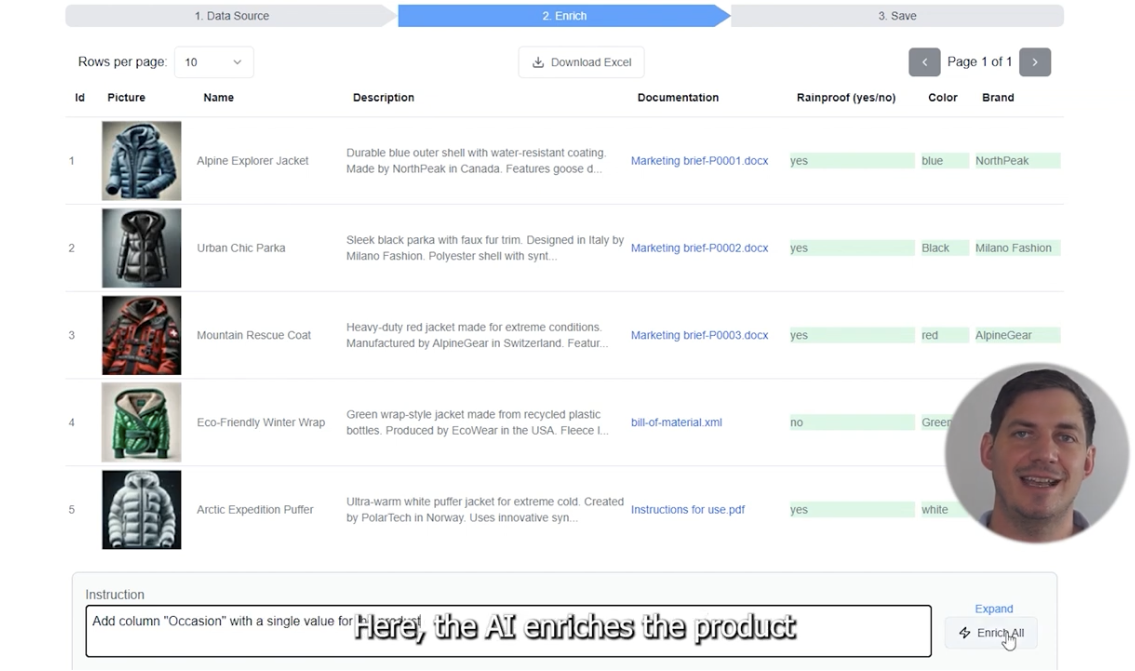The New Reality of AI in PIM
When Sports Group Denmark reduced their product content preparation time from two months to just a few days, they didn't just improve efficiency – they fundamentally transformed how modern businesses approach product information management. This isn't science fiction; it's happening now, powered by the sophisticated integration of AI and PIM systems.

AI-Powered PIM Transformation Results
Visual representation of the dramatic time reduction achieved by Sports Group Denmark - from 2 months to just a few days for product content preparation
Real-World Success: Learn how Sports Group Denmark reduced their product content preparation from two months to just a few days through AI-powered PIM integration. Read the full case study →
12 Advanced Benefits That Transform Your Business
Based on real implementations and measurable results, here are the advanced benefits that modern AI brings to PIM systems:
1. Exponential Time Reduction: From Months to Days
The most dramatic benefit isn't just speed – it's the complete transformation of workflows. Sports Group Denmark's journey from 2-month preparation cycles to mere days represents a 30x improvement in time-to-market. This isn't achieved through simple automation but through intelligent AI that understands context, maintains brand voice, and adapts to different markets simultaneously.
Key capabilities:
- Generate 2,000 product descriptions in hours instead of weeks
- Maintain consistent brand voice across all content
- Automatic adaptation for different markets and languages
- Human-in-the-loop validation ensures quality without bottlenecks
2. Multi-Market Intelligence at Scale
GANNI's implementation across 33 markets and 6 languages showcases how AI doesn't just translate – it localizes. The system understands cultural nuances, local preferences, and market-specific terminology, creating content that resonates with each audience while maintaining brand consistency.
Comparison table data is incomplete. Please check the content configuration.
3. Predictive Data Quality Management
Modern AI doesn't just fix errors – it prevents them. By analyzing patterns in your product data, AI can predict and prevent quality issues before they impact customers. This proactive approach has shown to reduce data quality incidents by up to 85% in mature implementations.
Proactive features:
- Anomaly detection catches outliers before publication
- Pattern recognition identifies incomplete product information
- Automatic suggestions for missing attributes based on similar products
- Real-time validation against business rules and compliance requirements
AI-PIM Integration Code Example
Example API call for triggering AI content generation within a PIM system
// AI Content Generation API Integration
const generateProductContent = async (productId, options) => {
const response = await fetch('/api/ai/generate-content', {
method: 'POST',
headers: {
'Content-Type': 'application/json',
'Authorization': `Bearer ${apiKey}`
},
body: JSON.stringify({
productId,
language: options.language || 'en',
contentTypes: ['description', 'features', 'benefits'],
brandVoice: options.brandVoice,
targetMarket: options.market
})
});
const result = await response.json();
// Update PIM with AI-generated content
await updatePIMProduct(productId, {
description: result.description,
features: result.features,
benefits: result.benefits,
aiGenerated: true,
lastUpdated: new Date().toISOString()
});
return result;
};Benefits 4-12: The Complete Transformation
4. Intelligent Content Orchestration
AI transforms PIM from a repository into an intelligent content orchestrator. It understands which content performs best on which channels, automatically adapting product information for Amazon, your website, social media, and B2B portals – each with optimized content that drives conversions.
5. Revenue-Driving Personalization
GANNI's 15% increase in online conversion rate came from their comprehensive digital transformation, with AI-powered product enrichment playing a key role. By analyzing customer behavior and preferences, AI helps tailor product information display, emphasizing attributes that matter most to each customer segment.
6. Autonomous Compliance and Classification
With 94% accuracy in commodity code classification achieved in just 0.3 seconds, AI eliminates one of the most tedious and error-prone aspects of product management. This extends beyond HS codes to include regulatory compliance, sustainability certifications, and market-specific requirements.
7. Visual Intelligence Integration
Beyond basic image tagging, modern AI extracts rich product attributes from images – colors, patterns, styles, and even emotional attributes. This visual intelligence feeds back into your PIM, creating more complete product profiles without manual input.
8. Predictive Inventory Intelligence
GANNI's 30 percentage point improvement in in-store inventory accuracy showcases how their digital transformation, including AI-powered PIM, extends beyond content. By analyzing product performance data, seasonal trends, and market signals, AI helps predict demand and optimize inventory distribution.
9. Continuous Learning and Improvement
Unlike traditional automation, AI-powered PIM systems learn from every interaction. They understand which product descriptions drive sales, which attributes customers search for, and which content formats perform best – continuously optimizing without manual intervention.
10. Cross-Functional Intelligence Hub
Modern AI transforms PIM into a central intelligence hub that serves multiple departments. Marketing gets conversion-optimized content, sales receives competitive intelligence, and operations gains supply chain insights – all from the same enriched product data.
11. Foundation for Company-Wide AI Strategy
PIM serves as the ideal starting point for building your comprehensive Company AI. The structured data, clear metrics, and immediate ROI make it perfect for training AI that can later expand to customer service, sales support, and marketing intelligence. Organizations that start their AI journey with PIM create a competitive advantage that extends far beyond product management.
12. Conversational Interface Revolution
AI agents and protocols like MCP (Model Context Protocol) enable natural language interaction with your PIM. Instead of complex queries and filters, teams can simply chat: "Find products missing sustainability info" or "Generate descriptions for our new collection emphasizing eco-friendly materials." This democratizes access to product data and accelerates decision-making across the organization.
Organizational Impact: See how centralized PIM systems transform back-office operations and cross-departmental collaboration. Explore the organizational benefits →
GANNI's Multi-Market Success
Global AI-Powered PIM Results:
- 33 Markets: Seamless localization across diverse regions
- 6 Languages: Automated, brand-consistent translations
- 15% Conversion Rate Increase: From AI-optimized product content
- 30% Inventory Accuracy Improvement: Better data quality and distribution
GANNI's success demonstrates how AI-powered PIM systems scale globally while maintaining brand consistency and market-specific optimization.
The Architecture Decision: Native AI vs. Headless AI
One of the most critical decisions in AI-powered PIM implementation is choosing between vendor-native AI features and headless, API-first AI solutions. This choice fundamentally impacts your flexibility, scalability, and long-term success.
Vendor-Native AI: The Integrated Path
Major PIM vendors are rapidly adding AI capabilities to their platforms, typically offering one of two approaches:
Native AI Tokens:
- Vendors provide their own AI capabilities through proprietary token systems
- Integrated directly into the PIM interface with pre-built workflows
- Often includes content generation, translation, and basic classification
- Trade-off: Higher cost per operation, locked into vendor's AI capabilities and roadmap
API Key Integration:
- Vendors support bringing your own API keys from providers like OpenAI, Anthropic, x.ai, or other AI services
- More flexible and cost-effective for high-volume operations
- Access to cutting-edge models as soon as they're released
- Trade-off: Requires more technical setup and management of multiple vendor relationships
Note: Sports Group Denmark used custom headless AI as an InRiver extension, demonstrating the hybrid approach rather than relying solely on native features.
Headless AI: The Flexible Future
The alternative approach – and increasingly the preferred one for forward-thinking organizations – is treating AI as a separate, best-of-breed layer:
Advantages of API-First AI:
- Vendor Independence: Switch AI providers without changing your PIM
- Best-of-Breed Selection: Use GPT-4 for content, Claude for analysis, specialized models for classification
- Rapid Innovation: Adopt new AI capabilities immediately as they emerge
- Cost Optimization: Pay only for what you use, scale elastically
- Custom Training: Fine-tune models on your specific data and requirements
Real-World Example:
GANNI's success came from combining InRiver's robust PIM foundation with custom AI integrations, not relying solely on native features. This hybrid approach delivered:
- 6 languages across 33 markets with specialized localization
- Custom brand voice preservation
- Market-specific compliance automation
The Hybrid Reality
In practice, the most successful implementations often combine both approaches. Sports Group Denmark exemplifies this perfectly – they use InRiver as their PIM foundation but implemented custom headless AI as an extension for content generation, achieving their dramatic time-to-market improvements.
- Use Native Features for Basics: Leverage vendor-provided AI for standard tasks like basic categorization or quality scores
- Add Headless AI for Differentiation: Build competitive advantages with custom AI integrations for complex tasks
- Maintain Flexibility: Ensure your architecture allows switching between native and external AI as needed
Headless AI Architecture Benefits
Key Components of Flexible AI-PIM Architecture:
- API Layer: Clean separation between PIM data and AI processing
- Multiple AI Providers: Use GPT-4 for content, Claude for analysis, specialized models for classification
- Custom Training: Fine-tune models on your specific product data and brand voice
- Scalable Processing: Handle thousands of products simultaneously with cloud-native AI
- Real-time Integration: Instant AI enhancements as products enter your PIM system
This architecture delivers both immediate results and long-term flexibility for AI innovation.
The Broader Vision: Company AI and Conversational PIM
Building Your Company AI: Start with PIM
Forward-thinking organizations are developing comprehensive "Company AI" strategies – custom AI models trained on their unique data, processes, and knowledge. PIM represents the ideal starting point for this journey:
Why PIM is the Perfect Training Ground:
- Structured Data: Product information provides clean, organized training data
- Clear Success Metrics: Easy to measure accuracy in descriptions, classifications, and attributes
- Immediate ROI: Direct impact on time-to-market and content quality
- Cross-Functional Relevance: Product data touches every department
The Expansion Path:
Once your AI masters product information, it naturally extends to:
- Customer Service: AI that truly understands your products can answer complex customer queries
- Sales Support: Provide detailed product comparisons and recommendations
- Marketing Intelligence: Generate campaign ideas based on product features and market trends
- Supply Chain Optimization: Predict demand based on product performance patterns
The Next Frontier: Conversational PIM with AI Agents
Imagine asking your PIM system: "Which products in our summer collection lack sustainability certifications?" or "Show me all products with declining sales that need refreshed descriptions."
AI Agent-Enabled PIM Features:
- Natural Language Queries: Chat with your PIM like a knowledgeable colleague
- Proactive Insights: AI agents that alert you to opportunities and issues
- Workflow Automation: "Update all outdoor furniture with weather-resistance ratings"
- Cross-System Intelligence: Agents that connect PIM with ERP, CRM, and marketing systems
Implementation via MCP (Model Context Protocol):
Modern protocols like MCP enable secure, controlled access for AI agents to interact with your PIM:
- Maintain data security and governance
- Enable complex, multi-step operations
- Preserve audit trails and compliance
- Scale from simple queries to complex automations
Real-World Example:
A furniture retailer implemented conversational PIM, enabling their team to:
- Ask: "Find all sofas without lifestyle images and generate shot lists for photography"
- Command: "Create Spanish descriptions for all new arrivals, emphasizing comfort features"
- Investigate: "Why are conversion rates lower for products with AI-generated content from Q2?"
Implementation Insights: Making It Real
The success stories of GANNI and Sports Group Denmark aren't accidents. Both leveraged InRiver's PIM capabilities but enhanced them with custom AI solutions. They follow proven patterns that any organization can replicate:
Start with Data Quality
AI amplifies what you feed it. Both successful implementations began by establishing clean, structured product data in their PIM systems. This foundation enabled AI to deliver immediate value rather than struggling with inconsistent inputs.
Embrace Human-AI Collaboration
The most successful implementations maintain human oversight. AI generates content in seconds, but human experts provide cultural validation and brand alignment. This collaboration model delivers both speed and quality.
Think Beyond Content
While content generation captures attention, the real value comes from AI's ability to connect dots across your entire operation. Use AI-powered PIM as a strategic asset that drives decisions across marketing, sales, and operations.
Making the Architecture Choice
Choose Native AI When:
- You need quick wins with minimal technical investment
- Your requirements align with vendor roadmaps
- You prefer single-vendor support and accountability
- Your use cases are relatively standard
Choose Headless AI When:
- You need cutting-edge AI capabilities
- Flexibility and vendor independence are priorities
- You have unique or complex requirements
- You want to maintain competitive advantage through custom AI
The Recommendation: Start with a hybrid approach. Use native features to prove value quickly, then layer in headless AI for differentiation. This provides both immediate ROI and long-term flexibility.
Explore complementary AI strategies and implementations that demonstrate similar methodologies
The Future Is Already Here
The question isn't whether to integrate AI with your PIM system – it's how quickly you can start. Organizations already leveraging these advanced benefits are pulling ahead, creating competitive advantages that compound over time.
As Sports Group Denmark discovered, the transformation from months to days isn't just about efficiency – it's about reimagining what's possible. When product information flows intelligently across your organization, enhanced by AI that understands context and intent, you're not just managing products anymore. You're orchestrating experiences that drive growth.
Ready to Transform Your PIM with AI?
The benefits outlined here aren't theoretical – they're drawn from real implementations delivering measurable results today. Whether you're looking to reduce time-to-market, improve content quality, or drive revenue through better product experiences, AI-powered PIM provides the foundation for transformation.



